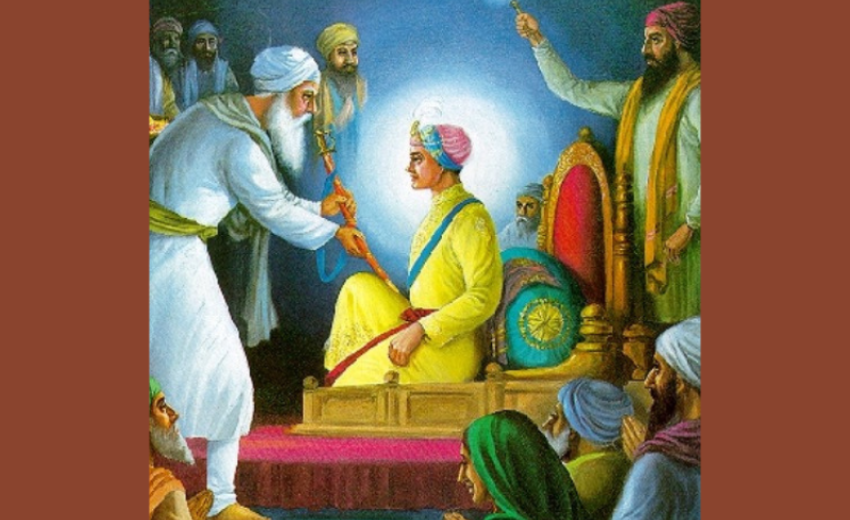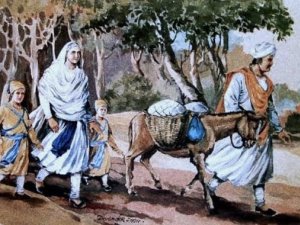Introduction
In the realm of popular beliefs, there exists a pervasive myth perpetuated by certain groups, alleging that the Sikh community obtained its military training from the Rajputs kings. This narrative asserts that it was the Rajput kings who imparted swordsmanship skills to the Sikh Gurus. Certain groups have crossed the line by claiming that these Rajput kings were the Gurus of the Sikh Gurus and that the Sikh community owes its entire legacy to them. The purpose of this article is to debunk such misconceptions and furnish readers with precise insights into the military training received by the Sikh Gurus.
Who gave military training to the sixth Sikh Guru?
It was during the time of the sixth Sikh Guru, Guru Hargobind Sahib Ji, that the military aspect of Sikhism became more formalized. Guru Hargobind Sahib Ji initiated the concept of the Sikh warrior tradition by organizing armed defense against persecution and oppression. He also introduced the concept of the Sikh community maintaining its own armed force, known as the "Akal Sena" or "Army of the Timeless One". This tradition of martial spirit and self-defense continued to be upheld and expanded upon by subsequent Sikh Gurus and leaders.
The martial ethos and military heritage of Sikhism find their roots in the era of the sixth Sikh Guru. Therefore, it becomes imperative to explore the origins of Guru Hargobind Sahib Ji's training in warfare and the inception of this esteemed military tradition.
Delving into this subject necessitates a reference to the ancient Sikh scriptures, revered as the foremost reservoirs of knowledge on the lives of the Sikh Gurus. In the case of Guru Hargobind Sahib Ji, two primary Puratan sources emerge as pivotal texts, offering intricate insights into his life's chronicles. While additional sources exist, they merely provide cursory glimpses into their existence and prove less beneficial for our inquiry. The two Puratan sources we shall utilize are:
1. Gurbilas Patshahi Chatvein (1720)
2. Suraj Pratap Granth (1843)
These two works stand as paramount repositories, meticulously chronicling the life and exploits of the sixth Guru, offering invaluable perspectives into his journey and the formation of the Sikh martial tradition.
Gurbilas Patshahi Chevein (1720)
The Gurbilas Patshahi Chevein stands as the primary source dedicated entirely to chronicling the life of Guru Hargobind Sahib Ji. It comprehensively encapsulates every significant event, ranging from the life of Guru Arjan
Dev Ji to the birth of Guru Hargobind Sahib Ji. This authoritative text meticulously documents his physical and spiritual development, his periods of incarceration, and his confrontations with the Mughal forces.
Today, our focus lies on uncovering the military mentor of Guru Hargobind Sahib Ji, an inquiry to which the Gurbilas Patshahi Chevein provides a definitive response.
According to Gurbilas Pashahi, when Guru Arjan Dev Ji recognized the need to commence the spiritual and martial training of his son, he sought the counsel of his elder brother, Baba Mahadev Ji, in search of a suitable mentor. Baba Mahadev Ji recommended Baba Budha Ji for the task, recognizing him as a venerable Gursikh who had been devoted to Guru Nanak Dev Ji since ancient times. Baba Budha Ji held an esteemed position, second only to the Sikh Gurus themselves, making him an ideal candidate to guide the education of Guru Hargobind Sahib Ji. [1]
Subsequently, Guru Arjan Dev Ji approached Baba Budha Ji, urging him to provide both military and spiritual instruction to his son. However, Baba Budha Ji, in humility, expressed his own lack of formal education. In response, Guru Arjan Dev Ji reassured him, affirming that his profound wisdom and innate eloquence were more than sufficient for the task at hand.
Baba Budha Ji initiated the military and spiritual tutelage of Guru Hargobind Sahib, and remarkably quickly, the gifted Guru acquired proficiency in a multitude of disciplines. These included weaponry, swimming, agriculture, horsemanship, administration, and various other skills under Baba Budha Ji's guidance. [2]
Gur Suraj Pratap Granth (1843)
Gur Suraj Prakash Granth is a sacred text in Sikhism. It was written by Bhai Santokh Singh, a Sikh scholar and poet, in the 19th century. The granth is a detailed historical account of the lives of the Sikh Gurus, starting from Guru Nanak Dev Ji, the founder of Sikhism, up to Guru Gobind Singh Ji, the tenth Sikh Guru. It's highly revered among Sikhs for its portrayal of Sikh history, philosophy, and spiritual teachings.
The Gur Suraj Prakash Granth provides an extensive narrative of Guru Hargobind Sahib Ji's life, offering insights into his military training as well. The account mirrors what we have already gleaned from the Gurbilas Patshahi Chevin. Similarly, the Gur Suraj Pratap Granth attributes the military and spiritual education of Guru Hargobind Sahib Ji to Baba Budha Ji and Bhai Gurdas Ji, respectively.[3]
Now, let’s have a glance at some modern sources :
1. The Sikh religion by Max Arthur Macauliffe
Macauliffe's narrative echoes the consistent portrayal found in the Puratan sources, affirming Baba Budha Ji's pivotal role in imparting military training to Guru Sahib. This alignment underscores the significance attributed to Baba Budha Ji's
mentorship in shaping Guru Sahib's martial prowess, highlighting the enduring reverence for his contributions within Sikh history.[4]
2. The Encyclopedia of Sikhism by Dr. Harbans Singh
The extensively researched Sikh Encyclopedia also confirms that Baba Budha Ji was the individual responsible for imparting military training to the sixth Guru. This authoritative source adds further weight to the historical narrative, highlighting Baba Budha Ji's pivotal role in shaping the martial skills of Guru Hargobind Sahib Ji. [5]
3. Sikh history by Dr. Ganda Singh
Renowned Sikh historian Dr. Ganda Singh also supports the assertion that Baba Budha Ji provided military training to the sixth Sikh Guru. [6]
Determining the religious affiliation of Rao Singha and Rao Jaita, figures commonly depicted as the teachers of Guru Hargobind Sahib Ji
As per the Encyclopedia of Sikhism, Bhai Singha and Bhai Jetha were esteemed warriors who were initiated as GurSikhs by Guru Arjan Dev Ji himself. They were tasked with serving Guru Hargobind Sahib Ji. [7] While it's possible that they assisted in the training of Guru Hargobind Sahib Ji, this is speculative as it's not explicitly stated. Additionally, both Bhai Singha and Bhai Jaita were devout followers of the Guru, ultimately obeying his instructions to care for his son.
After examining both Puratan and modern texts, it can be concluded that the military training of Guru Hargobind Sahib was primarily facilitated by Baba Budha Ji. Additionally, it is conceivable that individuals such as Bhai Singaru, Bhai Jetha, Bhai Bidhi Chand, and numerous other GurSikhs may have also played supportive roles in his training.
Who gave military training to the tenth Sikh Guru ?
In discussions surrounding Guru Gobind Singh Ji, a mysterious figure named Bajjar Singh Rathore is frequently cited as the Guru's military trainer. However, some right-wing propagandists have crossed a line by suggesting that Bajjar Singh was actually the Guru of Guru Gobind Singh Ji. Today, we will delve into the myth of Bajar Singh to ascertain whether he was indeed a real historical figure or simply a product of myth and legend.
The name Bajar Singh Rathore does not appear in any significant Sikh literature. His association as the teacher of Guru Gobind Singh Ji was first introduced by Padam Singh Piara in his work, Guru Kian Sakhian.[8]
However, Piara's reference to Bhatt Vahis Mohranvali, which supposedly supports this claim, does not mention Bajjar Singh's role as Guru Gobind Singh Ji's teacher. Additionally, in his editorial edition of Guru Kian Sakhian, Padam Singh Piara explicitly identifies Bajar Singh Rathore as Guru Gobind Singh Ji’s military instructor. However, the original Guru Kian Sakhian merely refers to a ‘Bajar Singh’ tasked with helping the young Guru to learn horse riding, without any mention of his surname "Rathore" or a broader role of him being a military instructor. [9]
It's indeed peculiar that the name of Bajjar Singh Rathore is conspicuously absent from the most prominent Sikh sources that extensively detail the life of Guru Gobind Singh Ji. Unlike the clear mention of Baba Budha Ji as Guru Hargobind Sahib Ji's military trainer in relevant sources, the absence of Bajjar Singh's name in sources pertaining to Guru Gobind Singh Ji's life raises questions about his historical existence as the Guru's military trainer. This discrepancy underscores the need for critical scrutiny and cautious interpretation of historical narratives surrounding Guru Gobind Singh Ji.
Now, the question arises who taught swordship to Guru Gobind Singh Ji ?
According to eyewitness Bhai Chaupa Singh Rahitnama, Guru Gobind Singh Ji acquired proficiency in swordsmanship, dagger skills, archery, and stave combat through looking at others and diligent practice, without the guidance of a designated instructor.[10]
Therefore, the assertion that Rajput kings or any non-Sikh instructed Guru Gobind Singh Ji in the art of swordsmanship is unfounded, as our analysis of prominent Sikh sources has demonstrated.
References
1. Gur Bilas Patshahhi Chevin by Bhagat Singh. Publication Bureau Punjabi University, Patiala pg no. 86 2. Gur Bilas Patshahhi Chevin by Bhagat Singh. Publication Bureau Punjabi University, Patiala pg no. 87 3. Sri Gur Pratap Suraj Granth Steek - Part 4 by Dr. Ajit Singh Aulakh pg no. 470
4. Sikh Religion: Its Gurus, Sacred Writings and Authors by Max Arthur Macauliffe Vol 3 pg no. 49-50 5. The Encyclopedia of Sikhism Volume 2 E-L by Harbans Singh Punjab University, Patiala pg no. 233 6. A Short History of Sikh by Dr. Ganda Singh and Teja Singh Punjab Publication pg no. 38 7. The Encyclopedia of Sikhism Volume 4 S-Z by Harbans Singh Punjab University, Patiala pg no. 203 8. Guru Kian Sakhian Piara Singh Padam pg no. 78
9. Bhai Saroop Singh Kaushik’s Guru Kian Sakhian English adaptation by Pritpal Singh Bindra pg no. 85 10. The Chaupa Singh RahitNama W.H.McLeod University of Otago Press Pg no. 167
Taranjeet Singh is a young, aspiring historian from Agra, Uttar Pradesh, with a profound passion for Sikh history. He has authored numerous articles that provide valuable insights, debunk misconceptions, and contribute to the understanding of Sikh heritage through meticulous research. Currently mentored by Mr. Inderjeet Singh, a respected member of the Institute of Sikh Studies and a regular contributor to the esteemed Abstract of Sikh Studies, Taranjeet Singh is dedicated to preserving and promoting the legacy of Sikh history with authenticity and rigor.


